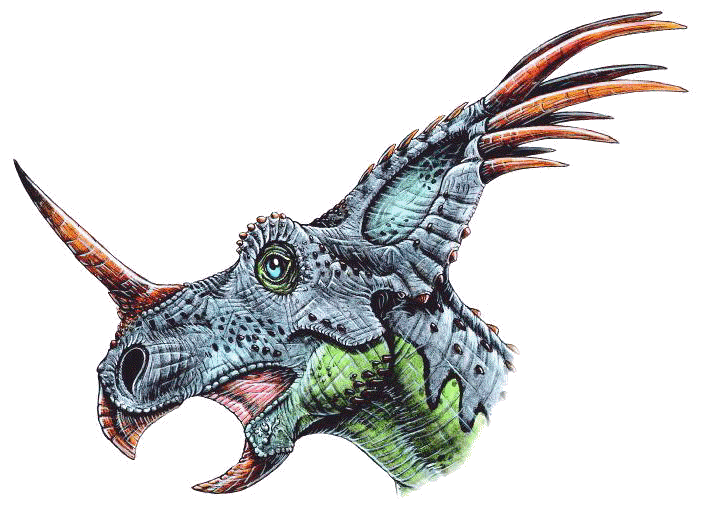|
||||||||||||||||||||
|
Styracosaurus is an ancestor of
the Triceratops. It lived about 10 million years before its
more famous relative. Not as large as Triceratops,
Styracosaurus had a row of long spikes around its frill. It also
had a long horn between its eyes and nose. This plant eater was
designed to chew up the very tough leaves of low-growing plants.>The long spikes and horn would have
made it difficult for the predators of that time, such as the early
tyrannosaur, Albertosaurus, to take on an adult
Styracosaurus. This creature had the typical features of the
ceratopsian dinosaurs - a beak that would have been used to cut the
leaves from the plants and a row of densely packed teeth to chew them
into pulp. There are several theories as to the
use of the spikes on the frill of Styracosaurus. In addition to
a defensive weapon, they may have served to make the creature look
larger and more formidable or they may have been brightly colored for
display during mating rituals. Styracosaurus may have been a herding animal, like some other ceratopsians. This hypothesis is supported by the finding of bone beds, large deposits of bones of the same species in an area. Styracosaurus hatched from eggs, and the young may have been cared for by parents. When threatened by predators, Styracosaurus may have charged into its enemy like a modern-day rhinoceros does. This would have been a very effective defense. Styracosaurus probably ate cycads, palms, and other prehistoric plants with its tough beak. It could also chew well with its cheek teeth (like other ceratopsians, but unlike most other dinosaurs). Styracosaurus was named in 1913 by L. M. Lambe from a fossil found near Alberta, Canada. Fossils have been found in the USA and Canada. A bonebed of about 100 Styracosaurus fossils was found in Arizona, USA, indicating that they travelled in herds. Styracosaurus, a familiar horned dinosaur of moderate proportions, is known only from the 76,000,000-year-old strata of Dinosaur Provincial Park, Alberta. A few articulated specimens have been discovered there, as well as concentrations of tumbled styracosaurus bones, which are suggestive of mass mortality. Resembling the rhinoceros in general appearance, horned dinosaurs did not hold their forelimbs directly beneath their bodies, and their jaws were adapted to chop, rather than grind, plant food. Many different horned dinosaurs of varying sizes and horn shapes are known from North America. Their ability to defend themselves is reflected in the presence of a bony lattice-work protecting the stomachs of the tyrannosaurs. Many modern day animals try to frighten
off attackers by making themselves look bigger than they actually are.
Styracosaurus must have used its huge neck frill in the same way. Its
neck frill had six long spikes protruding from its edge, and a 2ft.
long horn on its snout would have made Styracosaurus a formidable
looking prey to any attacker. Any predator attacking the herd would
have risked being charged by a male Styracosaurus and gouged in the
stomach by its horn. Styracosaurus was an herbivorous dinosaur from the Cretaceous period. It had six long horns extending from its neck frill, a smaller horn above each of its eyes, and a single horn protruding from its nose at 60 centimeters (2 feet) long and 15 centimeters (6 inches) wide. It was a large dinosaur, reaching lengths of 5 meters (18 feet) and weighing as much as 3 tons. It stood about 1.8 meters (6 feet) tall. The first fossil remains of Styracosaurus were discovered in Alberta, Canada in 1913, in an area now known as the Dinosaur Provincial Park. The Styracosaurus possessed four short legs and a bulky body, and was probably able to achieve speeds of up to 32 kilometers per hour (20 miles per hour). Its tail was rather short. It also had a beak and cheek teeth, indicating that its diet was herbivorous and composed mostly of Cycad palms, and other prehistoric plants. Like other ceratopsians, this dinosaur was most likely a herd animal, traveling in large groups and caring for its young after they hatched. Further evidence of this exists in the discovery of a bonebed in Arizona, USA with about 100 Styracosaurus fossils. |
||||||||||||||||||||
|
||||||||||||||||||||
